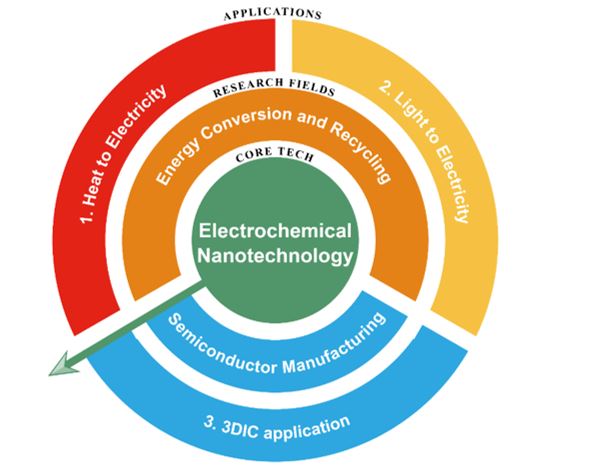Video Article Open Access
Electrochemical Nanotechnology for Energy Applications and Semiconductor Manufacturing
Shien-Ping Feng*, Yu-Ting Huang, Wei-Ting Wang, Chang Liu, Kaiyu Mu
Mechanical Engineering, The University of Hong Kong, Hong Kong
Vid. Proc. Adv. Mater., Volume 3, Article ID 2203271 (2022)
DOI: 10.5185/vpoam.2022.03271
Publication Date (Web): 23 Jul 2022
Copyright © IAAM
Graphical Abstract

Abstract
My research focuses on the development of new electrochemical technology for low-grade heat recovery, solar and indoor light harvesting, and nanomaterial fabrication. Firstly, my team invented a new electrochemical system named direct thermal charging cell (DTCC) for efficient conversion of low-grade heat to electricity, which is at the forefront performance compared with the existing systems in the low-grade heat regime [1]. The system used asymmetric electrodes of graphene oxide (GO)/Pt nanoparticles cathode and polyaniline anode in aqueous Fe2+/Fe3+ redox electrolyte for efficient conversion of low-grade heat to electricity. Continuous energy conversion is achieved under isothermal heating throughout the charge and discharge process. The system can be self-regenerated when cooled down, thus allowing device cyclability. By establishing startup and collaborating with industries, the invention has been moved from academic research toward real products in various applications, such as HVAC, smart window, and self-powered/wearable technologies. This new technology is expected to open new horizons for many applications, bringing tangible economic and environmental benefits [2]. Secondly, as the trap-state density in perovskite film is critical especially under indoor light, we developed a triple-anion perovskite film, of which the bandgap is specially designed to better fit the indoor light spectrum to achieve a record high IPV efficiency with excellent long-term performance [3,4]. The involvement of both bromide and chloride suppresses the trap-states and non-radiative recombination loss. The introduction of chloride restrains the halide segregation of iodide and bromide, stabilizing the perovskite film. This work realizes a stable and high-efficiency indoor perovskite cell (PSC) for potential applications in indoor-located and self-powered IoT devices. Last, we recently started to work with our industrial partners on electroplating technology for semiconductor manufacturing. My team developed effective additives to control the ratio and distribution of nanotwin/nanograin in the electroplated Cu, achieving high mechanical strength and thermal stability, defect-free solder/Cu interface, and superfilling ability, which can be used to fabricate redistribution layer (RDL) and Cu pillar for 3D IC packaging applications [5].
Keywords
Low grade heat; thermoelectrochemical, perovskite, indoor light, 3D IC packaging.
Acknowledgement
The authors acknowledge the financial support of General Research Fund of the Research Grants Council of Hong Kong Special Administrative Region, China under Award Number 17206519 and 17203520, and Innovation and Technology Fund (Ref: ITS/171/16FX).
References
- X. Wang, Y. T. Huang, C. Liu, K. Mu, K. H. Li, S. Wang, Y. Yang, L. Wang, C. H. Su, S. P. Feng, Nature Communications, 2019, 10, 4151 (Featured in Editors' Highlights).
- C. Liu, Q. Li, S. Wang, W. Liu, N. X. Fang, S. P. Feng, Nano Energy, published online, 2021.
- R. Cheng, C. C. Chung, H. Zhang, F. Liu, W. T. Wang, Z. Zhou, S. Wang, A. B. Djurišić, S. P. Feng, Advanced Energy Materials, 2019, 9, 1901980 (Featured as front cover).
- W. T. Wang, P. Chen, C. H. Chiang, T. F. Guo, C. G. Wu, S. P. Feng, Advanced Functional Materials, 2020, 30, 1909755,
- Z. Zheng, Y. T. Huang, Z. Wang, M. Zhang, C. C. Chung, S. J. Cherng, W. T. Wang, Y. H. Tsai, P. C. Li, Z. Lu, C. M. Chen, S. P. Feng, Nanotechnology, 2021, 32, 225702.
Biography
Tony Shien-Ping Feng is an Associate Professor of Mechanical Engineering at The University of Hong Kong (HKU). He received his BS, MS, PhD from National Tsing Hua University, Taiwan. Before entering academia, he was an engineer, principal engineer, and section manager at Taiwan Semiconductor Manufacturing Company (TSMC) from 2001 to 2008 and a deputy director at Tripod Technology Corporation from 2008 to 2009. He was employed as a Postdoctoral Associate at Massachusetts Institute of Technology from 2009 to 2011. He joined HKU as an Assistant Professor in October 2011 and was promoted to Associate Professor with tenure in September 2017. His research focuses on the development of electrochemical technology for low-grade heat recovery, solar and indoor light harvesting, and nanomaterial fabrication. Dr. Feng’s research has been well funded by external competitive grants as well as industry from Hong Kong, China, Taiwan and USA. He has published 120 journal papers and holds 21 patents. Through his patented technologies, Dr. Feng and his team established two start-up companies. Dr. Feng received the HKU Research Output Prize and Faculty Knowledge Exchange Award, the Silver Medal Award at the 2nd Asia Exhibition of Inventions, the Gold Medal and Top 10 Best Invention Award at the 5th International Invention Innovation Competition in Canada (iCAN), the Business Start-up Award and Energy Award at the IChemE Global Awards (one of the world’s most prestigious chemical engineering awards), the Gold Medal at the 48th International Exhibition of Inventions Geneva (2021 Special Edition), and the IAAM Scientist Medal from International Association of Advanced Materials (IAAM, Sweden). He is a Chartered Engineer (CEng), a Chartered Scientist (CSci), a Fellow (FIMMM) of the Institute of Materials, Minerals & Mining, and a Fellow (FRSC) of the Royal Society of Chemistry.
Video Proceedings of Advanced Materials

Upcoming Congress



